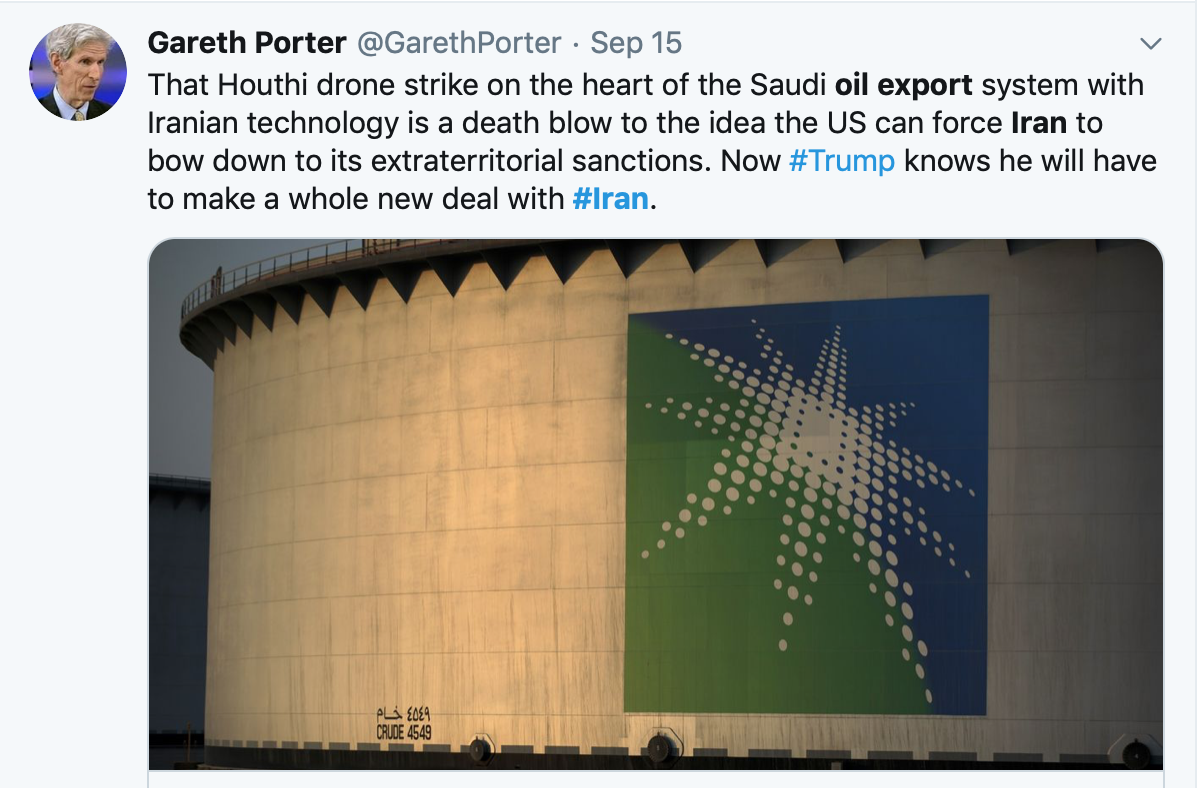The New Pivot Point: Iran Wants Peace but is Ready to Embrace War to Survive

“Since the US revoked waivers for even modest imports of Iranian oil, half a dozen tankers have been sabotaged or seized in the Persian Gulf, and America and Iran nearly went to war after Iran shot down an expensive American drone in June.”
With claims now surfacing that Iran contributed, at least in part, to the attack last week on Saudi Arabia’s Aramco facilities — an attack that led to a significant spike in oil prices and consequently triggered fears that markets could tank under such strain — geopolitical tensions in the Gulf region have reached a new peak.
On the heels of U.S. President Donald Trump’s comments on Twitter that all was in fact “locked and loaded,” a flurry of experts and other media professionals began discussing what seems to be an inevitable confrontation between the United States of America and Iran’s Islamic Republic.
A Political Impasse
Comments this Tuesday by Ayatollah Ali Khamenei, Iran’s Supreme Leader, that the country was in no way, shape or form interested in talks only added a layer of complication to an otherwise problematic political impasse … that and, of course, Trump’s decision to slap additional sanctions against the regime.
Boxed in both politically and economically, Iran has been left with little incentive toward peace.
Amid such a storm, it appears many are missing the bigger picture. The real point of contention has little to do with Iran’s innocence, or for that matter, perceived belligerence – let’s not forget that the Houthis of Yemen did, in fact, claim full responsibility for the oil attack through all manners of great details – but rather Iran’s designs for the regions in the face of economic disintegration.
Allow me to roll back the clock a few months, July 4th to be precise, when Britain decided, at the insistence of its U.S. ally to seize one of Iran’s oil tankers, the Grace I, on the basis that its load, earmarked for Syria, was in contravention of E.U. sanctions on Syria.
While Britain and its allies were keen to describe the move as legally sound and thus necessary to the good policing of our international waters, Iran very much understood such “aggression” as yet another swipe at its sovereignty, yet another attempt by western powers to impose their diktat over those they deem “unfit.”
It is actually this very narrative that has allowed Tehran to weather more than a few storms over the decade. While many Iranians may not agree with the ideological foundations of Iran’s system of governance – the Governance of the Jurist – an overwhelming majority of them are more than willing to back the regime to the bitter end if it means defending their nation’s territorial integrity and sovereignty.
Sovereignty and nationalism are values Iranians take very seriously indeed and few will dare hold it against them, especially if we consider that for most nations those values are in fact virtues. President Donald Trump did, after all, made it the very center of his presidential rhetoric.
Iran’s Resistance Economy
Under punishing sanctions, Iran is undoubtedly feeling the strain. Unable to rejoin the world energy market, cut off from all main financial forums, its products shun, Iran is suffocating. This is not to say that Iran cannot withstand the pressure, only that doing so will come at a great cost – such a cost, the regime understands, may be too much to ask of regular Iranians.
If Iran has long been an adept of what it refers to as a “resistance economy,” a system based on the mastery of economic self-sufficiency, the Islamic Republic is running out of both space and oxygen. That said, it will serve us well to remember that Iran’s resistance economy allowed the country since 1979 to successfully sustain growth and reduce poverty, a feat that should not be discounted. Iran knows and can dig its heels if it needs to; it can also lash out if it feels cornered.
If the U.S. aims to drive Iran’s oil exports to zero, it may not be fully realized yet — the month of July saw exports plunge almost 80% year-on-year — their lowest levels since the Iraq-Iran War that ended in 1988, a drop which has been felt throughout the country, all sectors and social circles compounded.
Iran is now exporting approximately 400,000 barrels of oil per day (BPD), down from a peak of nearly 2.5 million BPD in April 2018, which led to a crunching fall in revenues.
Oil revenues account for about 40 percent of Iran’s national income.
While Washington may argue that such pressures are designed to force Tehran back to the negotiating table — a logic that is clearly falling on deaf ears, Iran is arguing economic terrorism, a move designed to rally public opinion behind its leadership, come what may.
Although the effect of America’s economic squeeze has been resounding on the Iranian economy, which is forecasted by the World Bank to shrink approximately 5 percent this year, it has also sharpened the teeth of the most docile of politicians as violence is being weighed as a better alternative to a slow, but sure, economic death.
A Will to Survive
With fears that any further economic hardship will tip Iran’s socio-political balance, the state is fast hardening its resolve to a full-blown conflict to avoid a popular insurrection.
In other words, Iran’s recent belligerence needs to be looked at not as political posturing but the expression of a nation’s will to survive — an act of self-defense against forces that seek its demise.

Further skirmishes in the Strait of Hormuz and other acts of defiance fall within the same rationale of self-defense.
As Barbra Slavin puts it in the American Conservative: “Since the US revoked waivers for even modest imports of Iranian oil, half a dozen tankers have been sabotaged or seized in the Persian Gulf, and America and Iran nearly went to war after Iran shot down an expensive American drone in June.”
Hardly the softening of tone Washington wanted to force Tehran to conform to.
Then the attack on Saudi Arabia …
In all truth, Iran’s guilt matters little here; what we need to concentrate on are both the drive behind Tehran’s foreign policy and the regional geopolitical alliances which are being formed as a result of America’s uber neoconism and Saudi Arabia hyperbolic paranoia.
With its back firmly pressed against the wall, Iran will sooner or later lash out … likely at its neighbors, might it be the Emirates or Saudi Arabia who will stand first in the firing line.
Shifting Power in the Middle East
Another point worth considering is Iran’s regional weight as well as the friends it keeps: Russia and China.
At such a time when the United States is engaged in a power struggle with both Russia and China, Iran may just have enough geopolitical “juice” to not only defy Washington, but manifest a new regional reality — one backed by those capitals which now look to Tehran as the new regional powerhouse, mainly Lebanon, Syria, Iraq and Yemen.
That, of course, leaves Saudi Arabia to suffer the cold air of America’s disinterest. For all his promises of actions and great warnings, President Trump is unlikely to tempt fate by shattering the ever thin ice financial markets are sitting on amid talks of a broad economic slowdown just to honor Riyadh’s calls for help.
















